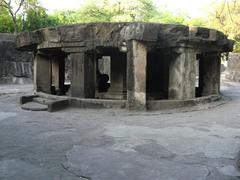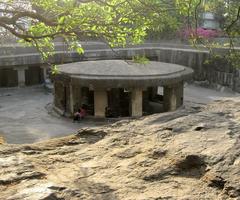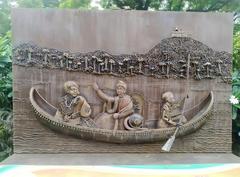
Pataleshwar Cave Temple Pune: Visiting Hours, Tickets, and History Guide
Date: 14/06/2025
Introduction
Located at the center of Pune, the Pataleshwar Cave Temple is a remarkable testament to India’s ancient rock-cut architecture and spiritual legacy. Dating back to the 8th century and carved during the Rashtrakuta dynasty, this monolithic basalt temple is dedicated to Lord Shiva. It stands as a living heritage site, drawing visitors with its blend of artistry, devotion, and historical relevance (The History Hub; TravelSetu). Its strategic location on Jangli Maharaj Road offers both accessibility and tranquility amidst Pune’s urban landscape.
This guide provides a detailed overview of the temple’s history, architecture, cultural significance, visiting hours, ticket and accessibility information, and practical tips for an enriching visit (GuideTour; TripzyGo).
Table of Contents
- Introduction
- Historical Background
- Visiting Information
- Visitor Experience
- Nearby Attractions
- Frequently Asked Questions (FAQs)
- Conclusion
- References
Historical Background
Origins and Construction
The Pataleshwar Cave Temple, also called Panchaleshvara or Bamburde, was constructed in the 8th century CE under the patronage of the Rashtrakuta dynasty (The History Hub; TravelSetu). Meticulously hewn from a single basalt rock, the temple reflects the artisans’ mastery and echoes the rock-cut tradition of sites like the Ellora Caves. Its sanctum houses a Shiva Linga, symbolizing the presence of Lord Shiva.
Architectural Features
The temple’s layout is both functional and symbolic. Its main sanctum (garbhagriha) is cube-shaped and enshrines the Shiva Linga. Expansive pillared corridors surround the sanctum, while the circular Nandi Mandapa, supported by original monolithic pillars, shelters Shiva’s sacred bull, Nandi (WanderOn). The unfinished sections of the temple, left rough-hewn due to a discovered fault line, provide insights into ancient construction techniques.
Key Architectural Highlights
- Mandapa (Pillared Hall): Spacious and supported by sturdy pillars, serving as an assembly and ritual space.
- Sanctum Sanctorum: Houses the Shiva Linga, a focal point for worship.
- Nandi Mandapa: A unique, circular pavilion with a monolithic Nandi statue facing the sanctum.
- Minimal Ornamentation: The temple’s aesthetic emphasizes form and space over intricate decoration.
- Natural Light: Openings and strategic design create a serene interplay of light and shadow, enhancing the spiritual ambiance.
Cultural and Religious Significance
Pataleshwar Cave Temple remains an active place of worship, especially vibrant during Maha Shivaratri and the month of Shravan, attracting thousands of devotees (WanderOn). It also hosts cultural events, music, and dance performances, making it a living hub of Pune’s spiritual and artistic life. The temple’s museum, adjacent to the complex, showcases rare artifacts, including a Guinness World Record-holding grain of rice inscribed with 5,000 characters (The History Hub).
Visiting Information
Hours, Entry, and Accessibility
- Visiting Hours: The temple is generally open every day from 8:30 AM to 5:30 PM, with some sources noting earlier opening (from 6:00 AM) and closing times up to 6:30 PM. It’s advisable to confirm timings before your visit (Holidify; HotelDekho).
- Entry Fee: There is no entry fee—admission is free for all visitors (HotelDekho).
- Accessibility: The cave temple is accessed via steps and uneven rock surfaces, making wheelchair access limited. The pathways are otherwise manageable for most visitors; assistance may be needed for those with mobility issues.
- Duration of Visit: Most visitors spend 1–2 hours exploring the temple and adjacent museum (Holidify).
Travel Tips
- Best Time to Visit: October to February offers pleasant weather; early mornings or late afternoons are ideal for avoiding crowds and heat (Luxe Vista).
- Getting There: Centrally located on Jangli Maharaj Road, the temple can be reached by auto-rickshaw, taxi, or public bus. Pune Junction railway station is 3–4 km away; Pune International Airport is 12–14 km away.
- Parking: Limited parking is available nearby; public transport is recommended during festivals or peak times.
- Dress Code: Modest attire is encouraged; remove footwear before entering the main sanctum.
- Photography: Permitted in outer areas; avoid flash and be respectful during worship.
Visitor Experience
The Pataleshwar Cave Temple offers a tranquil retreat, with shaded, cool interiors and a peaceful garden. The temple’s unique monolithic architecture and spiritual ambiance invite meditation and introspection. The adjacent museum enhances the visit with rare exhibits, and occasional guided tours deepen appreciation for the site’s heritage (TripzyGo).
Amenities:
While there are no dedicated cafes or restrooms on-site, nearby streets provide various dining and restroom facilities.
Nearby Attractions
Combine your temple visit with these Pune highlights:
- Shaniwar Wada: Historic Peshwa-era fort, 1 km away.
- Shreemant Dagdusheth Halwai Ganpati Mandir: Renowned Ganesh temple, 1.5 km away.
- Mahatma Phule Museum: Local historical museum.
- J.M. Road Markets and Cafés: Ideal for shopping and local cuisine (HotelDekho).
Frequently Asked Questions (FAQs)
Q: What are the temple’s visiting hours?
A: The temple is generally open daily from 8:30 AM to 5:30 PM, though some sources mention hours from 6:00 AM to 6:30 PM.
Q: Is there an entry fee or ticket required?
A: No, entry is free and no tickets are needed.
Q: Are guided tours available?
A: Yes, local guides offer tours at the temple entrance, and group tours may be arranged.
Q: Is the temple wheelchair accessible?
A: Accessibility is limited due to steps and uneven rock floors.
Q: When is the best time to visit?
A: October to March, or early mornings/late afternoons to avoid crowds and heat.
Q: What should I wear?
A: Modest attire is recommended, and shoes must be removed before entering the sanctum.
Conclusion
The Pataleshwar Cave Temple is a jewel of Pune’s heritage—a serene, ancient monument where history, art, and spirituality converge. Free to enter and easy to reach, it welcomes all visitors, offering a profound connection to India’s past and enduring religious traditions. Enhance your visit by exploring nearby attractions and planning during festival periods for a vibrant cultural experience.
For more tips and personalized travel planning, download the Audiala app and follow us for updates on Pune’s heritage sites.
References and Further Reading
- The History Hub
- TravelSetu
- GuideTour
- TripzyGo
- Holidify
- HotelDekho
- Luxe Vista
- WanderOn
- Pataleshwar Cave Temple Guide
- Pataleshwar Temple Pune
- Pataleshwar Cave Temple Pune







